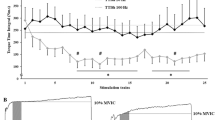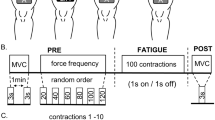Abstract
Twenty-three females between the ages of 19 and 35 were studied in order to compare the effects of variations in pulse duration, waveform symmetry, and source regulation on comfort during quadriceps surface stimulation at amplitudes necessary to produce 27 Nm torque. Stimulation parameters compared were: 1) 50 and 300 μs pulse durations, 2) asymmetrical and symmetrical biphasic waveforms, and 3) current and voltage source regulation. Subjects overwhelmingly preferred the 300 μs pulse duration regardless of waveform or source regulation, strongly preferred the symmetrical biphasic waveform, and had inconsistent preference for either regulated voltage or regulated current sources.
Similar content being viewed by others
References
Baker, L., C. Yeh, D. Wilson, and R. Waters. Electrical stimulation of wrist and fingers for hemiplegic patients.Phys. Ther. 59(12):1495–1499, 1979.
Benton, L., L. Baker, B. Bowman, and R. Waters.Functional Electrical Stimulation—A Practical Clinical Guide, 2nd Edition. Downey, CA, Professional Staff Association of Rancho Los Amigos Hospital, 1981.
Crago, P.E., P.H. Peckham, J.T. Mortimer, and J.P. van der Meulen. The choice of pulse duration for chronic electrical stimulation via surface, nerve, and intramuscular electrodes.Ann. Biomed. Eng. 2:252–264, 1974.
Dimitrijevic, M., F. Gracanin, T. Prevec, and J. Trontelj. Electronic control of paralyzed extremities.Bio-Med. Eng. 3:8–19, 1968.
Gracanin, F., and A. Trnkcozy. Optimal stimulus parameters for minimum pain in the chronic stimulation of innervated muscle.Arch. Phys. Med. Rehabil. 56(6):243–249, 1975.
Lee, K., and R. Johnston. Electrically induced flexion reflex in gait training of hemiplegic patients: Induction of the reflex.Arch. Phys. Med. Rehabil. 57(2):148–152, 1977.
Liberson, W., H. Holmquist, D. Scot, and M. Dow. Functional electrotherapy: Stimulation of the peroneal nerve synchronized with the swing phase of gait in hemiplegic patients.Arch. Phys. Med. Rehabil. 42:101–105, 1961.
Milner, M., A.O. Quanbury, and J.V. Basmajian. Surface electrical stimulation of the lower limb.Arch. Phys. Med. Rehabil. 51:540–548, 1970.
Moreno-Aranda, J., and A. Seireg. Electrical parameters for over the skin muscle stimulation.J. Biomech. 14:579–585, 1981.
Notermans, S.L.H. Measurement of the pain threshold determined by electrical stimulation and its clinical application. Part I. Method and factors possibly influencing the pain threshold.Neurology 16:1071–1086, 1966.
Ship, G., and N. Mayer. Clinical usage of functional electrical stimulation in upper motor neuron syndrome. InFunctional Electrical Stimulation, edited by T. Hambrecht and J. Reswick, New York, Marcel Dekker, Inc., pp. 65–82, 1977.
Takebe, K., C. Kukulka, M. Narayan, M. Milner, and J. Basmajian. Peroneal nerve stimulator in rehabilitation of hemiplegic patients.Arch. Phys. Med. Rehabil. 56:237–240, 1975.
van den Honert, C., and J.T. Mortimer. The response of the myelinated nerve fiber to short duration biphasic stimulating currents.Ann. Biomed. Eng. 7:117–125, 1979.
Vodovnik, L., C. Long, E. Regenos, and A. Lippay. Pain response to different tetanizing currents.Arch. Phys. Med. Rehabil. 46:187–192, 1965.
Stevens, L.S., A.S. Carton, and G.M. Shickman. A scale of apparent intensity of electric shock.J. Exp. Psychol. 56:328–334, 1958.
Ekman, G., M. Frankenhaeuser, S. Levander, and I. Mellis. Scales of unpleasantness of electrical stimulation.Scand. J. Psychol. 5:257–261, 1964.
Author information
Authors and Affiliations
Rights and permissions
About this article
Cite this article
Bowman, B.R., Baker, L.L. Effects of waveform parameters on comfort during transcutaneous neuromuscular electrical stimulation. Ann Biomed Eng 13, 59–74 (1985). https://doi.org/10.1007/BF02371250
Issue Date:
DOI: https://doi.org/10.1007/BF02371250




